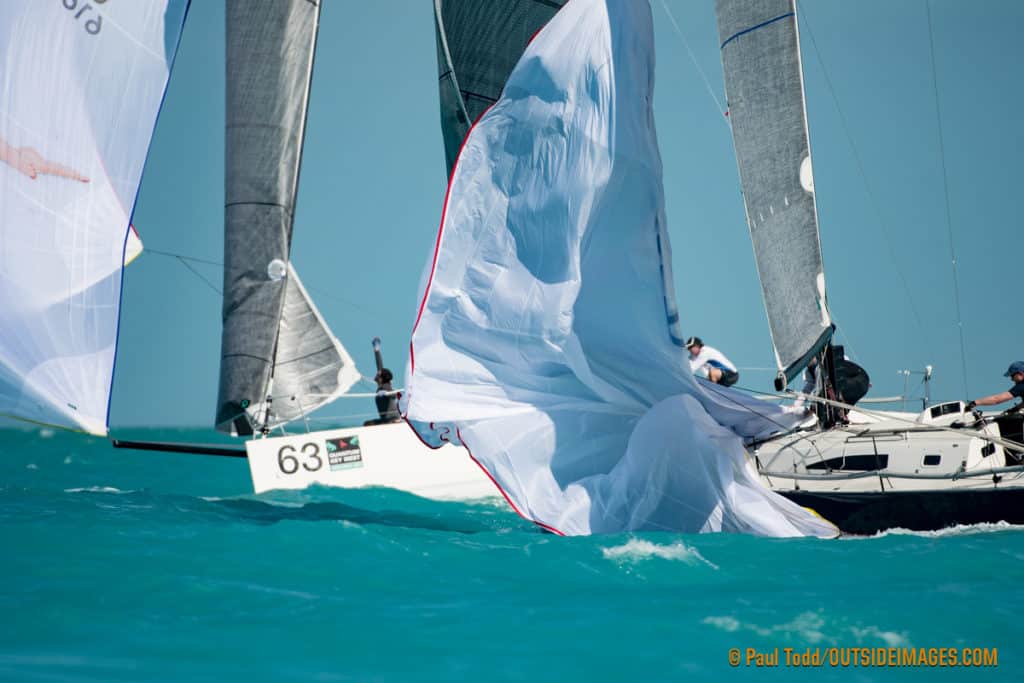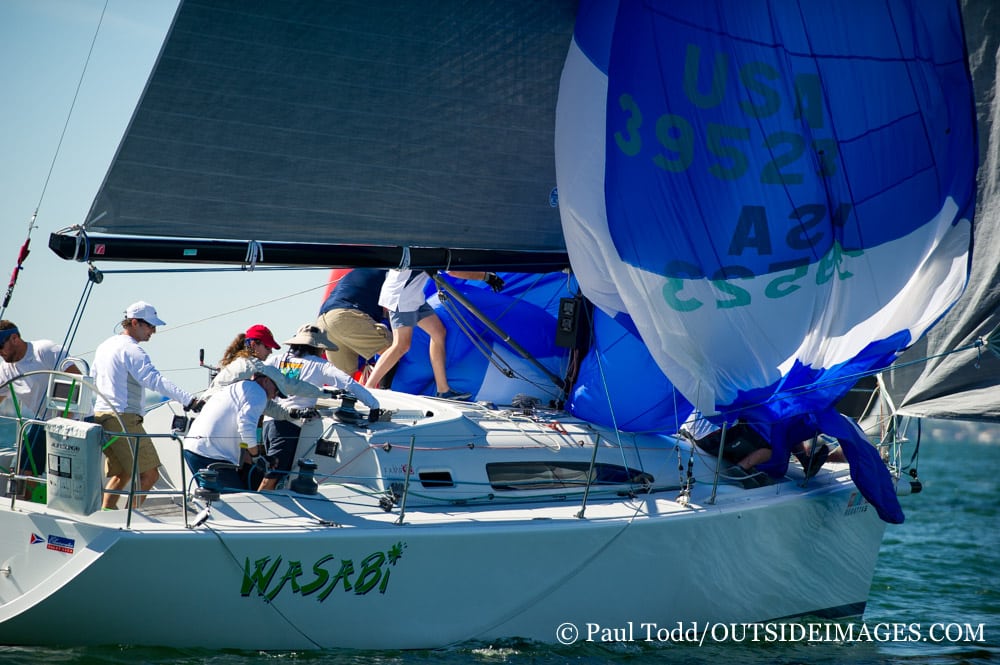
The true grade of any spinnaker douse on an asymmetrical sportboat can’t be recorded until that boat has rounded the ensuing top mark. Did the spinnaker hoist easily and fill correctly the second time? Did one or more crewmembers have to spend any portion of the beat down below repacking the kite?
Along with a tidy and timely takedown at the leeward mark, a top-shelf maneuver requires the answers of “yes” and “no,” respectively, to those key questions. The best A-sail drops allow the team to cleanly hoist the spinnaker at the next mark with little or no clean-up work in between. This, in turn, allows for maximum hiking effort, which is crucial since asymmetrical sportboats are usually lighter than symmetrically-rigged boats and more sensitive to weight on the rail.
Generally speaking, retractable bowsprits reduce the number of crew required to sail a boat, and make the downwind maneuvers slightly less complicated. However, while the douse may require fewer bodies, timing and technique are just as important, especially when the goal is to get the spinnaker below decks and ready to be re-hoisted before turning upwind.
What is the best technique for dropping the spinnaker on a 30- to 45-foot sportboat? This usually depends on the approach to the leeward mark. In this article I will outline the key components of three different A-sail drops. Mastering all three will enable your team to handle the toughest conditions with aplomb, and provide your tactician the confidence to make the right call regardless of the maneuver’s level of difficulty.
The Windward Drop
This is the safest of the three drops, and it’s quite easy. The sequence goes like this:
Release the tack line and the working sheet completely.
AdvertisementUsing the windward spinnaker sheet, pull the clew around the headstay.
Ease the halyard and pull the kite into the hatch, starting with the center of the foot.
As with most drops, getting the helmsman to put the bow close to dead downwind, which reduces the apparent wind, will make things a lot easier on the crew. One person, maybe two depending on the size of the sail and the wind strength, will be needed to overhaul the windward sheet from behind the windward shrouds. Another person, most likely the bowman, positions himself just in front of the front hatch to gather the foot and feed it to the final member of the takedown team, who is down below. This crewmember’s job is to pull the sail through the hatch as fast as possible. The person on deck at the hatch has to make sure the foot does not go in the water. This is crucial. The person at the shrouds should pull the clew back quickly and then help get the sail down by pulling along the leech tape. Running the leech tape during a douse will help keep the sail from twisting, and ensure it’s ready for the next hoist.
The Jibe Drop
Sometimes called a Mexican drop or a Kiwi drop, this is a really slick drop when done properly, but the timing is more difficult than a windward drop because the douse must coincide with a perfect turn from the helmsman.
Start turning the boat into a jibe
The trimmer and grinder work together to oversheet the spinnaker, using the sheet that was controlling the sail before the jibe. Ideally, the spinnaker will be trimmed in so that the foot of the sail can be grabbed by a member of the bow team. In heavier air, this can be difficult and may require starting the overtrim earlier.
AdvertisementThe pit person should open the halyard clutch when the sail is above the boat. Too late is better than too early. The sail should blow into the mast and rigging and then down onto the foredeck, if it is dropped too early the sail will fall into the water.
Starting ideally with the center of the foot, the bow team pulls the sail down the hatch. Once the bow team gets hold of the foot, the trimmer should strip the sheet from the winch, enabling it to run free as the sail is sucked below. The last thing to be released is the tack line. When the bowman has the foot in the boat, he should call for the release of the tack line.
The positions of the bow team remain largely the same as for the windward drop. One twist, however, is that the bowman must duck underneath the foot of the spinnaker as the boat jibes and get to the new windward side. The jib must be tended during this maneuver. It’s best to keep it a little overtrimmed during the douse to keep the battens from wrapping around the headstay and to keep the spinnaker from blowing out to leeward of the boat.
The crucial part of the drop is the turning of the boat. The bow needs to come down into a jibe-as with the windward drop, the closer the boat is to dead downwind, the less apparent wind there is-but then stay low after the jibe until the sail is down the hatch. This can produce a long, slow turn, so the tactician and helmsman must ensure the approach vector to the leeward mark positions the boat with enough distance to windward of the mark to complete a proper turn for this drop. When done properly, the sail should almost fall down onto the deck. As with the windward drop, someone should follow the leech tape down to keep the sail clean for the next set.

The Leeward Drop
The easiest drop with a symmetric spinnaker is the toughest for asymmetrical sailors.
The helmsman needs to bring the bow down enough to allow the bowperson to grab the foot of the sail. This may also require the trimmer and grinder to bring the sail in. For this douse, a retrieval line attached to the middle of the foot of the spinnaker can be useful.
Once the foot is within the control of the bow person, it’s time to drop the sail. The first third of the halyard should be eased very fast to unload the sail and allow the bow team to get the foot under control. From that point, the pit person will need to watch the bow team as they gather and drop the sail accordingly, making sure to keep it out of the drink.
The tack line is eased last.
A more challenging variation on the leeward drop is the high-angle leeward drop, where the option of heading down to take the load off the sail isn’t available. Releasing the sheet will turn the spinnaker into a big flag out in front of the boat. The only way to unload the sail is by releasing the halyard. Once the sail is unloaded, then the sheet has to be overtrimmed so the bow team can get their hands on the foot. The sail will be very close to the water, or even in it, but as long as the foot of the sail does not hit the water the sail will came onboard relatively easily.
Aside from the greater loads, this drop can require the bow team to pull the spinnaker over the lifelines and under the foot of the upwind headsail. It can also require the crew to work on the leeward rail, which may be underwater. It’s best to avoid this type of drop if possible, even if that means going to the unfavored gate, or doing a really sharp turn. The cost of a botched spinnaker takedown can be significantly worse.
Each of these douse techniques should become an integral part of your team’s playbook. During the course of a long series or regatta, you’re likely to have the opportunity to use all of them.
The afterguard must understand what is involved in each drop and consider these factors when deciding on the final approach to the leeward mark. Having a clear plan going into the mark will help the boathandling, and allow for a better escape. The amount of distance to leeward needed to complete the drop in a timely manner must be factored into layline decisions. A perfect layline call usually puts a boat two or three boatlengths to windward of the actual layline.
Having the sail put away as the boat rounds the mark, with the whole crew on the rail, should always be the goal. If you have to err, do so on the side of being conservative and taking the spinnaker down early. The losses that come from a twist in the sail at the set or the sail getting in the water at the drop can be enormous.









